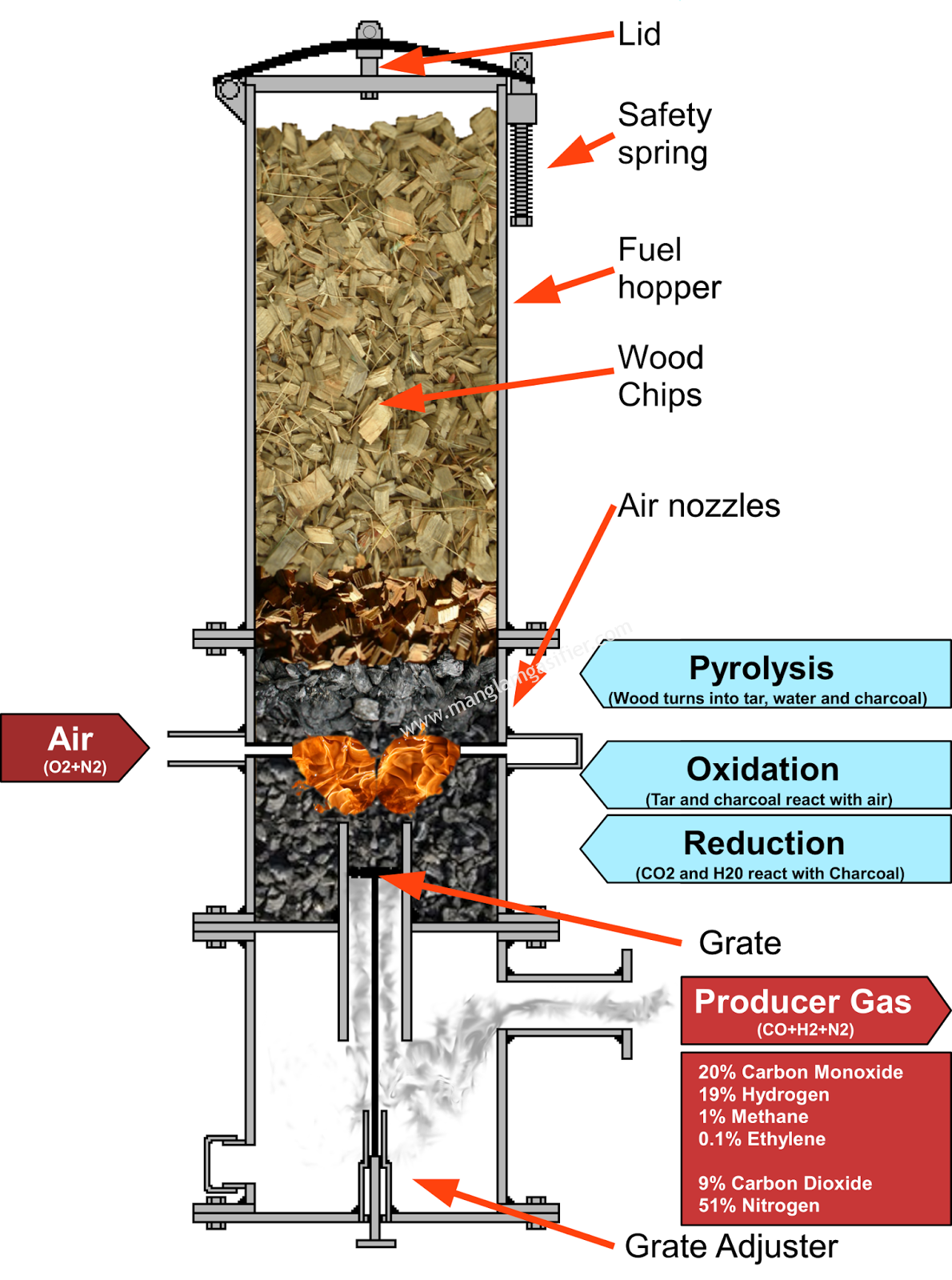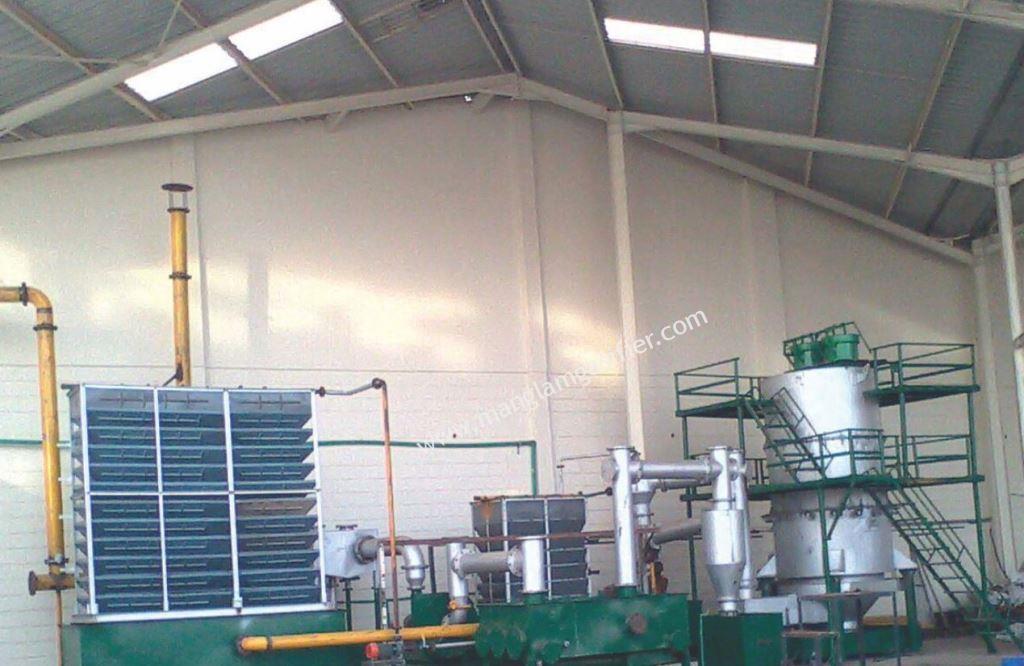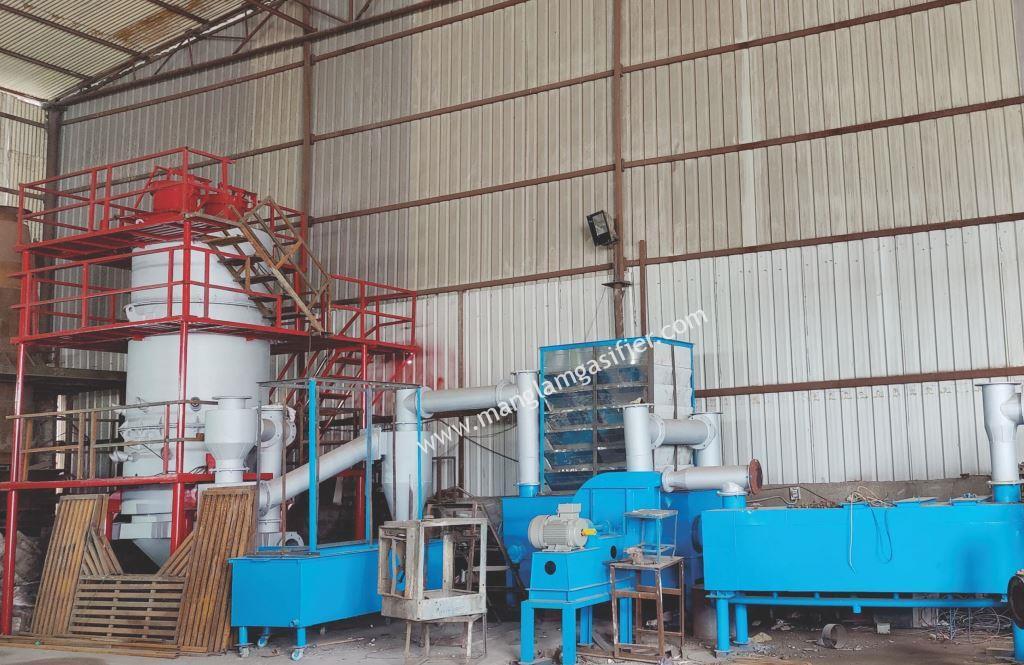What is Biomass Gasification?
The biomass gasification process basically converts almost all the forms of
biomass or solid fuels (such as, agricultural residues, corn-wastes, rice-
husks, woods, wood-wastes, etc.) into a combustible gas mixture known as producer gas. The producer gas is comprised of carbon
monoxide, hydrogen, carbon dioxide, methane and nitrogen. This process of
conversion is typically used for various biomass materials, and it partially limits the combustion of such biomass during the process. The partial combustion occurs when the intake of air (oxygen) supply is controlled and
its less than adequate quantity is fed into the system for the combustion of biomass.

The overall process is a combination of four distinct processes -
- Drying of Biomass Fuel
The moisture in the feed comes out in this zone in the form of water vapour. Drying takes place in the upper most portion of the Gasifier, through heat transferred from the high temperature combustion zone.
- Pyrolysis
Pyrolysis means heating in absence of oxygen at high temperatures. The organic biomass is thus chemically decomposed and volatiles are released in gaseous form and char is produced.
- Combustion
Combustion is the process of burning in presence of controlled oxygen and as a result heat and energy are released.
- Reduction
CO2 and H2O obtained as the combustion products get reduced by carbon in the presence of high temperature to finally give CO and H2.
What is a Biomass Gasifier?
The Biomass Gasifier is basically a chemical reactor in which thermo-chemical processes mentioned above take place simultaneously. It carries out the conversion of solid biomass fuel into producer gas consisting of carbon monoxide, hydrogen, carbon dioxide, methane and nitrogen.
The resulting fuel gas has a calorific value of 1000-1200 kcal/nm3, and can directly be burnt with high efficiency and good degree of control without the emission of smoke. The produced gas flame temperature can be as high as 1100oC. Each kilogram of air-dried biomass with 10% moisture content yields about 2.5 nm3 of producer gas. In energy terms, the conversion efficiency of the gasification process is in the range of 80-90%.
Following are The Two Kinds of Biomass Gasifiers :
Downdraft Biomass Gasifier
Updraft Biomass Gasifier
Downdraft Biomass Gasifier
In Downdraft Gasifier System, the controlled intake of air (oxygen) is fed
into the chamber containing downward movement of biomass material.
After going through the process, the producer (inflammable) fuel gas is
finally collected and drawn off at the bottom of this Gasifier. It is an efficient
technique which has the capacity to process the biomass containing
moderate moisture (up to 30%). About 5-10 minutes are needed to
ignite the combustion and bring the plant to an operative temperature.
Downdraft Gasifier is best suitable for applications where the
temperature control is critical, and cleaner fuel gas is required. These
Gasifiers can be used in those applications where moderate temperature is
required up to 1100oC.
Updraft Biomass Gasifier
In Updraft Gasifier System, air (oxygen) supply is fed into the chamber at
the bottom, and this air flow acts as countercurrent to the movement of
biomass material. After going through the process, the producer
(inflammable) fuel gas rises upward and is finally collected and drawn off at
the upper part of this Gasifier. It contains clearly allocated zones for the
partial combustion, reduction and pyrolysis process of the biomass. Updraft
Gasifier achieves higher efficiency as the hot air passes through biomass
material bed and leaves the Gasifier at lower temperature. The heat given
off during the process of gasification is used for preheating and drying the
fed biomass.
Updraft Gasifier is best suited for the applications where moderate amount of dust in the fuel gas is acceptable and a higher flame temperature is required.
What are The Process Benefits?
Below mentioned are some of the advantageous features of the Manglam Biomass Gasification Systems that can be an ideal solution for your Industrial Power needs.
- Manglam Biomass Gasifier replaces the use of expensive liquid/gaseous fuels like L.D.O./F.O./CNG/LPG/Diesel/CNG by low cost solid fuels without any changes in operations, temperature profile, temperature control and cleanliness in the plant area.
- Typically the cost of replacing 1 ltr/kg of liquid/gaseous fuel works out to be Rs 15 to 20, depending on the application and type of fuel used for gasification.
- The heat can be increased/reduced by just adjusting a valve.
- Very low maintenance, no operative risk, easy to operate.
- Zero Tar/Effluent system & highest overall efficiency.
- Auto ash removal system.
- Worldwide environment friendly accepted renewable technology.
- It offers clean combustion, high thermal efficiency and a good degree of control just like conventional diesel burners.
- No emission of smoke from the gasifier.
- Replace fossil fuels & reduce oil import.

Areas Of Application
Power Generation
The producer gas generated from Manglam Biomass Gasifier can be fed to
engine-gensets for producing power and is one of the reliable sources of
green energy.
| Unit of Power | Biomass Consumption (kg) |
|---|---|
| 1 kWh | 1.2-1.4 kg |

Thermal Application
The versatility of gasification process allows it to be used in wide range of
industrial thermal applications. The industries where the usage of this technology has been successfully adopted are as under –
Bakeries:
Fried Foods
Furnaces
Drying and Curing Applications
Steam Boilers
Bakeries:
- Rotary Oven
- Swing Tray
- Moving Tray
- Biscuit Oven
Fried Foods
- Potato chips plant
- Namkeen fryer
- Automatic Continuous fryer
- Bhujia bhatti
- Big kitchens
Furnaces
- Rotary Continuous Annealing of Steel, Aluminium etc.
- Batch Annealing of Steel, Aluminium etc.
- Pop Rotary Kiln
- Lube and Grease Refinery Furnace
Drying and Curing Applications
- Tea Dryers
- Coffee Curing
- Mosquito Coils
- Paper Drying
- Wood Drying
- Fibre Heating Zone
Steam Boilers
- Confectionery Industries
- Pharmaceuticals
- Textile
- Chemicals
- Packaging Industry
- Food processing industries
We can offer Energy Solutions to any industry with thermal power requirements.
These are just a few names out of the many industries that we have served! If you did not find yours listed here then no need to be disappointed!
Fill the details below and let us help curate a cost saving strategy for you!
Want Us To Reduce Your Fuel Cost?
Contact Customer Support

